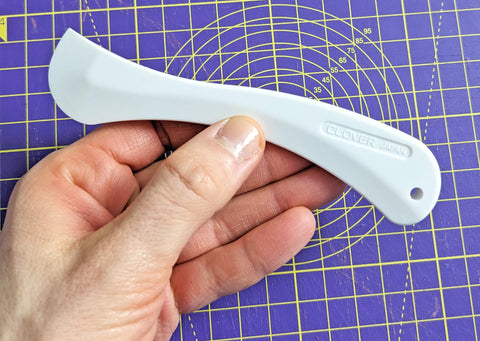What is Free Motion Quiting
Free Motion Quilting, also known as FMQ, is a super fun way of quilting a quilt. It gives you freedom of movement with your machine as the feed-dogs (those metalic 'teeth' grabbing and moving your fabric), are lowered down using a special lever located on your machine (usually, at the back).


This is where I lower mine on my Pfaff Quilt Ambition 630
That freedom that FMQ gives you also requires a bit more practice than your regular 'quilting with a walking foot technique' as well as a solid plan on how you want to quilt your quilt when the time comes.

One of my Free Motion Quilt samples
Now, let's talk about best practices when doing FMQ on a quilt.
FMQ: Tips and Tricks
-
Free Motion Quilting is great for both straigth and curved quilt design.
- Doodle the design on a piece of paper and practice using a manageable sized piece of backing fabric + wadding + top fabric.
- Mark the design on the fabric and follow it if needed. I usuallu use a Hera Marker for this or a Frixion Pen that goes away when ironed.

The Hera Marker doesn't leave a harsh mark and it goes away after a bit of time

The Frixion Pen is one of my favourite tools to mark fabric
- Go for basic designs such as meandering, echoing, waves and wonky lines, wonky lines and stars, letters, loops, pebbles, spirals, switch backs, swirl chain, zigzag meander, wishbones, diamonds… (you can find them easily online or on YouTube).
- There are specific quilt rulers made for Free Motion Quilting. Their use depend on your design and level of expertise. I think in general they are a great help when you now how to use them.

Some FMQ quilting rulers I got to practice different designs
- There are also specific FMQ presser feet that you will need to test and use on your machine (it took me a while to get to know the best ones for mine). There are feet for ruler use (wider at the bottom) and for non-ruler use: open-toe, clear and closed-toe.

These are some of my FMQ presser feet
- When you are ready to start, take the bottom thread up, then make a couple of stitches in place and then focus on one part of the quilt each time (a specific block or unit within the quilt).
- I recommend using quilting gloves as they help a lot with moving the quilt around and also a Supreme Slider. The pink sticky back grips the bed of your machine and keeps the slider from shifting while you work. The zero-friction Teflon top allows your project to move freely so you can easily slide your project around as you quilt.

- Try to use a new needle each time you start a new quilt (there are specific ones for quilting) and quality thread.
- The tension on the thread depends on the wadding and on the design. Test to find the one that works best between speed on machine and movement of hands. Check the back as well to see if the tension is OK and try to go for medium speed. Check the tension every time you start a new quilt, a new bobbin or thread colour, when changing the needle and after switching off the machine. Do loops and zigzags when testing.
LOWER number means LOOSER top tension.
- Some of the most common tension issues are Eyelashes, happening on the back and caused by the top tension being too loose and pulling to the back. Or Floaters, if the top thread is floating,you need to loosen your tension. If your back thread is floating, tighten it.
- Also, you can adjust the presser foot pressure if needed.
HIGHER number means MORE pressure. For thinner fabrics or layers.
LOWER number means LESS pressure. For heavier fabrics or layers.
Last, I want to finish this post by mentioning an amazin FMQ tutor, Quilting American royalty Angela Walters
. Her YouTube channel is packed with tutorials!And that is it for this post! I hope you found it useful and interesting. If you have more pressing tips, don't hesitate to share them below :)
Happy quilting!
Ana
xxx
